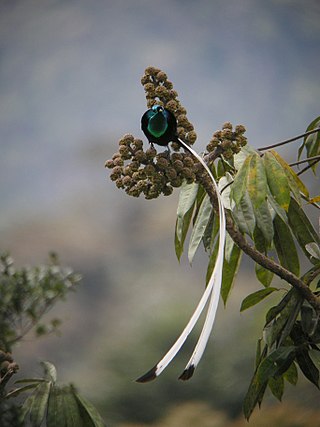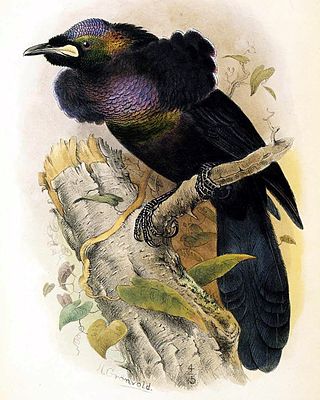
The birds-of-paradise are members of the family Paradisaeidae of the order Passeriformes. The majority of species are found in eastern Indonesia, Papua New Guinea, and eastern Australia. The family has 45 species in 17 genera. The members of this family are perhaps best known for the plumage of the males of the species, the majority of which are sexually dimorphic. The males of these species tend to have very long, elaborate feathers extending from the beak, wings, tail, or head. For the most part, they are confined to dense rainforest habitats. The diet of all species is dominated by fruit and to a lesser extent arthropods. The birds-of-paradise have a variety of breeding systems, ranging from monogamy to lek-type polygamy.

The Phasianidae are a family of heavy, ground-living birds, which includes pheasants, partridges, junglefowl, chickens, turkeys, Old World quail, and peafowl. The family includes many of the most popular gamebirds. The family is a large one and includes 185 species divided into 54 genera. It was formerly broken up into two subfamilies, the Phasianinae and the Perdicinae. However, this treatment is now known to be paraphyletic and polyphyletic, respectively, and more recent evidence supports breaking it up into two subfamilies: Rollulinae and Phasianinae, with the latter containing multiple tribes within two clades. The New World quail (Odontophoridae) and guineafowl (Numididae) were formerly sometimes included in this family, but are now typically placed in families of their own; conversely, grouse and turkeys, formerly often treated as distinct families, are now known to be deeply nested within Phasianidae, so they are now included in the present family.

Lapwings are any of various ground-nesting birds akin to plovers and dotterels. They range from 10 to 16 inches in length, and are noted for their slow, irregular wingbeats in flight and a shrill, wailing cry.

The red junglefowl is a tropical bird in the family Phasianidae. It ranges across much of Southeast Asia and parts of South Asia. It was formerly known as the bankiva or bankiva fowl. It is the species that gave rise to the chicken ; the grey junglefowl, Sri Lankan junglefowl and green junglefowl have also contributed genetic material to the gene pool of the chicken.

Vanellus is the genus of waders which provisionally contains all lapwings except red-kneed dotterel, Erythrogonys cinctus. The name "vanellus" is Latin for "little fan", vanellus being the diminutive of vannus. The name is in reference to the sound lapwings' wings make in flight.

The Sri Lankan junglefowl, also known as the Ceylon junglefowl or Lafayette's junglefowl, is a member of the Galliformes bird order which is endemic to Sri Lanka, where it is the national bird. It is closely related to the red junglefowl, the wild junglefowl from which the chicken was domesticated. However, a whole-genome molecular study rather show that Sri Lankan junglefowl and grey junglefowl are genetically closer species than the red junglefowl. Sri Lankan junglefowl and red junglefowl diverged about 2.8 million years ago, whereas time of divergence between the Sri Lankan junglefowl and grey junglefowl was 1.8 million years ago.

The paradise flycatchers (Terpsiphone) are a genus of birds in the family Monarchidae. The genus ranges across Africa and Asia, as well as a number of islands. A few species are migratory, but the majority are resident. The most telling characteristic of the genus is the long tail streamers of the males of many species. In addition to the long tails the males and females are sexually dimorphic and have rufous, black and white plumage.

The gray junglefowl, also known as Sonnerat's junglefowl, is one of the wild ancestors of the domestic chicken together with the red junglefowl and other junglefowls.

The green junglefowl, also known as Javan junglefowl, forktail or green Javanese junglefowl, is the most distantly related and the first to diverge at least 4 million years ago among the four species of the junglefowl. Hybridization with domestic chicken has also been reported. Green junglefowl is a medium-sized bird in the pheasant family Phasianidae.

The genus Paradisaea consists of six species of birds-of-paradise. The genus is found on the island of New Guinea as well as the nearby islands groups of the Aru Islands, D'Entrecasteaux Islands and Raja Ampat Islands. The species inhabit a range of forest types from sea level to mid-montane forests. Several species have highly restricted distributions, and all species have disjunct distributions. A 2009 study examining the mitochondrial DNA of the family found that the Paradisaea birds-of-paradise were in a clade with the genus Cicinnurus. It showed that the blue bird-of-paradise was a sister taxon to all the other species in this genus.

Astrapia is a genus of birds-of-paradise. The genus contains five species, all endemic to New Guinea. The males have highly iridescent plumage and remarkably long tails. Females are duller and have shorter tails.

The black sicklebill is a large member of the birds of paradise family, Paradisaeidae. This species is found throughout most of central New Guinea and the Vogelkop region to the northwest in montane forests at altitudes from 1800 to 2150 m.

Epimachus is a genus of birds-of-paradise (Paradisaeidae) that includes two species, found in the highland forests of New Guinea. They are the largest members of the family. The common name "sicklebill" refers to their long, decurved, sickle-shaped bill.

The long-tailed paradigalla is a large, approximately 37 cm long, black bird-of-paradise with long and pointed tail. One of the most plain members in the family Paradisaeidae, its only adornment is the colorful facial wattles of yellow, red and sky-blue near base of the bill. Both sexes are similar in appearance, however the female is slightly duller and smaller.

The short-tailed paradigalla is a species of bird-of-paradise.

Stephanie's astrapia, also known as Princess Stephanie's astrapia, is a species of bird-of-paradise of the family Paradisaeidae, native to the Bird's Tail Peninsula. This species was first described by Carl Hunstein in 1884.

The genus Ptiloris consists of four allopatric species of birds in the family Paradisaeidae. These birds of paradise are commonly known as riflebirds, so named for the likeness of their black velvety plumage to the uniform of the Rifle Brigade. Alternatively, the bird's cry is similar to a rifle being fired and hitting its target but a call like this is not commonly reported. They are distributed in the rainforests of New Guinea and Eastern Australia.

Rothschild's lobe-billed bird-of-paradise, also known as the noble lobe-bill, is one of six enigmatic species of bird-of-paradise collected in Papua New Guinea for zoologist Walter Rothschild, 2nd Baron Rothschild. It is only known from the holotype.

Buteogallus is a genus of birds of prey in the family Accipitridae. All members of this genus are essentially neotropical, but the distribution of a single species extends slightly into the extreme southwestern United States. Many of the species are fond of large crustaceans and even patrol long stretches of shore or riverbank on foot where such prey abounds, but some have a rather different lifestyle. Unlike many other genera of raptor, some members are referred to as "hawks", and others as "eagles".
The false-lobed astrapia, also known as the false-lobed long-tail, is a bird in the family Paradisaeidae that is a presumed intergeneric hybrid between a long-tailed paradigalla and black sicklebill. Another interpretation that has been put forward is that the only known specimen is an immature Elliot's bird-of-paradise.


















